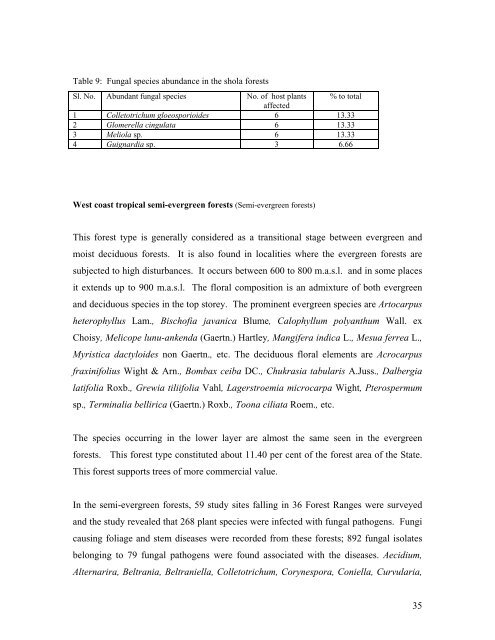Biodiversity of Plant Pathogenic Fungi - Kerala Forest Research ...
Biodiversity of Plant Pathogenic Fungi - Kerala Forest Research ...
Biodiversity of Plant Pathogenic Fungi - Kerala Forest Research ...
You also want an ePaper? Increase the reach of your titles
YUMPU automatically turns print PDFs into web optimized ePapers that Google loves.
Table 9: Fungal species abundance in the shola forests<br />
Sl. No. Abundant fungal species No. <strong>of</strong> host plants<br />
affected<br />
% to total<br />
1 Colletotrichum gloeosporioides 6 13.33<br />
2 Glomerella cingulata 6 13.33<br />
3 Meliola sp. 6 13.33<br />
4 Guignardia sp. 3 6.66<br />
West coast tropical semi-evergreen forests (Semi-evergreen forests)<br />
This forest type is generally considered as a transitional stage between evergreen and<br />
moist deciduous forests. It is also found in localities where the evergreen forests are<br />
subjected to high disturbances. It occurs between 600 to 800 m.a.s.l. and in some places<br />
it extends up to 900 m.a.s.l. The floral composition is an admixture <strong>of</strong> both evergreen<br />
and deciduous species in the top storey. The prominent evergreen species are Artocarpus<br />
heterophyllus Lam., Bisch<strong>of</strong>ia javanica Blume, Calophyllum polyanthum Wall. ex<br />
Choisy, Melicope lunu-ankenda (Gaertn.) Hartley, Mangifera indica L., Mesua ferrea L.,<br />
Myristica dactyloides non Gaertn., etc. The deciduous floral elements are Acrocarpus<br />
fraxinifolius Wight & Arn., Bombax ceiba DC., Chukrasia tabularis A.Juss., Dalbergia<br />
latifolia Roxb., Grewia tiliifolia Vahl, Lagerstroemia microcarpa Wight, Pterospermum<br />
sp., Terminalia bellirica (Gaertn.) Roxb., Toona ciliata Roem., etc.<br />
The species occurring in the lower layer are almost the same seen in the evergreen<br />
forests. This forest type constituted about 11.40 per cent <strong>of</strong> the forest area <strong>of</strong> the State.<br />
This forest supports trees <strong>of</strong> more commercial value.<br />
In the semi-evergreen forests, 59 study sites falling in 36 <strong>Forest</strong> Ranges were surveyed<br />
and the study revealed that 268 plant species were infected with fungal pathogens. <strong>Fungi</strong><br />
causing foliage and stem diseases were recorded from these forests; 892 fungal isolates<br />
belonging to 79 fungal pathogens were found associated with the diseases. Aecidium,<br />
Alternarira, Beltrania, Beltraniella, Colletotrichum, Corynespora, Coniella, Curvularia,<br />
35

















